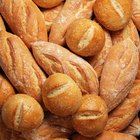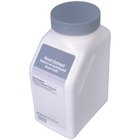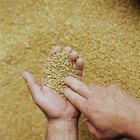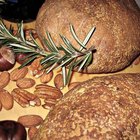
Recipes designed to take advantage of bread machines typically use quick-rising or instant yeasts, which can be added directly to the dough like any other dry ingredient. Older recipes, intended for hand mixing, often instruct bakers to first proof the yeast by activating it in warm water or milk. Proofing is a relatively quick way for bakers to ensure that the yeast is fresh and lively, before going to the trouble of mixing bread with it.
A Close Look at Yeast
Yeasts are among the most common microorganisms on the planet, in the air everywhere. One family of natural yeasts digests the natural sugars in grain and converts them into varying proportions of alcohol and carbon dioxide, depending whether beer or bread is the desired end result. Yeast was first purified in the 19th century, but keeping the tiny organisms alive was sometimes problematic. Cakes of fresh yeast quickly deteriorate and lose their leavening power, especially if they're carelessly handled. Active dry yeast is better suited for long storage, though it also loses potency over time.
Finding Some Proof
Expending the time and effort to mix bread dough, only to find that the yeast was dead, was even more frustrating in the days before powerful stand mixers and bread machines. In self-defense, bakers adopted the habit of testing their yeast to prove its viability. The yeast must be crumbled or stirred into either a cup of warm milk, or a cup of warm water with a small amount of sugar added. If the yeast is fresh, it will foam vigorously in its warm bath as the microorganisms wake from their dormant condition and begin to eat and reproduce. This is proof that the yeast is alive and potent, so the process is often called "proofing."
Proofing in Milk
Milk contains natural sugars such as lactose, so it can support a lively growth of yeast without any added table sugar. Fresh or cake yeast should react and begin to grow immediately, as soon as it's well moistened by the warm milk. Active dry yeast can take 10 to 15 minutes to reach its full potential, because the granules of dormant yeast are surrounded by a protective dry coat of dead yeast cells. That outer layer must be fully hydrated and dissolved by the milk before the living yeast cells inside can begin to feed and reproduce.
Whether to Proof
Bread bakers are sharply divided over whether it's still necessary to proof yeast. Improved manufacturing and packaging processes have greatly improved the reliability of dry yeast, and most retailers manage coolers and expiration dates well enough for fresh cake yeast to give predictable results. As a result, many bakers skip the proofing step and add the yeast directly to their dough. However, if you don't know the age or origin of the yeast you're using, proofing is a relatively quick and simple step that can save you a measure of frustration later.
Related Articles

When Does Dry Yeast Expire?

What Is the Finger Test for Bread Dough?

A List of Leavening Agents

How to Grow Bread Yeast

Why Does Bread Drop in the Middle When ...
Can You Refrigerate Homemade Yeast ...

Does Yeast Cause Holes in Bread?

Does Yeast Turn Juice to Alcohol?

Can You Get Sick From Baking Bread With ...

What Are Ingredients in Wheat Bread?

What Are the Benefits of Torula Yeasts?

Adding Cream of Tartar to Macaroons

What Happens if the Yeast Dies Before ...

How to Make Bread Tender

Can Fast Acting Yeast Be Used in Place ...
How to Make Bread That Does Not Crumble ...

How to Ferment Grains

What Is Artisan Bread?

What Causes Honey to Ferment?

Can You Refrigerate Homemade Yeast ...
References
- On Food and Cooking: The Science and Lore of the Kitchen; Harold McGee
- King Arthur Flour: Baker's Yeast
Writer Bio
Fred Decker is a trained chef and prolific freelance writer. In previous careers, he sold insurance and mutual funds, and was a longtime retailer. He was educated at Memorial University of Newfoundland and the Northern Alberta Institute of Technology. His articles have appeared on numerous home and garden sites including GoneOutdoors, TheNest and eHow.
Photo Credits
Hemera Technologies/AbleStock.com/Getty Images